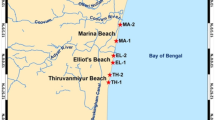Abstract
In a case study involving preliminary investigations for the feasibility of a beach resort complex in the west coast of Sarawak, Malaysia, since the acceptable quality of recreational water quality had not been specified, existing international standards and practices were reviewed to arrive at acceptable microbiological and physicochemical parametric levels. Water samples were collected on a weekly basis in the proposed beach complex at Tanjong Batu Coastal Reserve and also along the nearby Sungei Batang Kemena and its estuary. It was ascertained that the swimming water quality was acceptable in terms of faecal Coliforms, temperature, pH and dissolved oxygen. However E. Coli counts did indicate a potential risk of 1.68% for gastrointestinal illness and the ubiquitous presence of faecal Streptococci pointed to recent pollution of human or animal origin. Besides, grease and oil contents exceeded the WHO Guideline values. It was hence recommended that an appropriate sanitation or pollution survey should be carried out in the adjacent coastal catchment area and the beach. Also routine water sampling should be undertaken. Such action will help to pinpoint sources of pollution and lead to antipollution measures, thus helping to upgrade swimming water quality and establish swimming water quality standards.
Similar content being viewed by others
References
APHA: 1985, Standard Methods for the Examination of Water and Wastewater, American Public Health Association, 16th edition, Washington DC, pp. 903–904.
Cabelli, V. J.: 1988, ‘Swimming-associated illness and recreational water quality’. Proc. IAWPRC Conference 10–15 July 1988, Brisbane, Australia, Rigden, B. and Henry, L. (Eds.), pp. 13–22.
Cabelli, V. J.: 1979, ‘Evaluation of recreational water quality, the EPA approach’, In Biological Indicators of Water Quality James, A. and Evison, L. (Eds.), Wiley Interscience, London, pp. 14–1 to 14–23.
California Health and Safety Code: 1975, Provision 20, Ch 1, Art 4, Sections 24155-9, Dept. of Public Health, 2151 Berkeley Way, Berkeley, California 94704.
Dufour, A. P.: 1977, ‘Escherichia Coli: The Faecal Coliform’. In Bacterial Indicators/Health Hazards Associated with Water, Hoadley, A. W. and Dukta, B. J. (Eds.) ASTM STP 635, Am. Soc. for Testing Materials, Philadelphia, USA, pp. 48–58.
Dutka, B. J.: 1973, ‘Coliforms are an inadequate index of water quality’, J. Environ. Health, 36, 39–46.
Environmental Health Directorate: 1978, ‘Recreational water quality’ 78-EHD-25, Information Services, Dept of National Health and WElfare, Ottawa K1A OL2, pp. 2.
Federal Provincial Working Group on Recreational Water Quality: 1983, Guidelines for Canadian Recreational Water Quality, Oct. 1983, Canadian Govt. Publishing Centre, Supply and Services Canada, Ottawa K1A 059.
Geldreich, E. E.: 1976, ‘Faecal coliform and faecal Streptococcus density relationships in waste discharges and receiving waters’, CRC Critial Rev. Environ. Control 6, 349.
Geldreich, E. E. and Kenner, B. A.: 1969, ‘Concepts of faecal streptococci in stream pollution’. JWPCF, 41, R336-R352.
Hart, B. T.: 1974, ‘A compilation of Australian Water Quality Criteria’, Australian Water Resources Council, Tech. Paper, No. 7, Australian Govt. Publishing Office, Canberra.
Iwato, Takeo: 1955, Dept of Sanitary Engineering, Institute of Public Health, Tokyo, Japan, 1955.
Mood, E. W.: 1968, ‘The role of some physico-chemical properties of water as causative agents of eye irritation of swimmers’. Report of Comm. of Water Quality Criteria, Federal Water Poll. Control Fed., US Dept of Interior, pp. 15–16.
Moore, B.: 1959, ‘Sewage Contamination of Coastal Bathing Waters in England and Wales-A Bacteriological and Epidemiological Study’, J. Hyg. 57, 435–472.
Newburg, L. H.: 1949, Physiology of Heat Regulation and the Science of Clothing, W.B. Saunders Co, Philadelphia, USA, pp. 457.
Stevenson, A. H.: 1953, ‘Studies of bathing water and health’, American J. Public Health, 43, 529–538.
U.S. Environment Protection Agency: 1976, Quality Criteria for Water. EPA-440/9-76-023, Washington DC. Official Journal of European Communities, 5 Feb 1976, No. L31/1, Council Directive of 8 Dec 1975 concerning the quality of bathing water (76/160/EEC).
Vollenweider, R. A.: 1968, ‘The scientific basis of lake and stream eutrophication with particular reference to phosphorus and nitrogen as eutrophication factors’. Tech. Rep. OECD Paris DAS/CSJ/68, 27, pp. 1–182.
World Health Organisation: 1974, ‘Guides and criteria for recreational quality of beaches and coastal waters’, Report of a Working Group of the Regional Office for Europe, Copenhagen.
Author information
Authors and Affiliations
Rights and permissions
About this article
Cite this article
Appan, A. A feasibility study for appraising recreational water quality in a Southeast Asian beach complex. Environ Monit Assess 19, 361–372 (1991). https://doi.org/10.1007/BF00401325
Issue Date:
DOI: https://doi.org/10.1007/BF00401325




